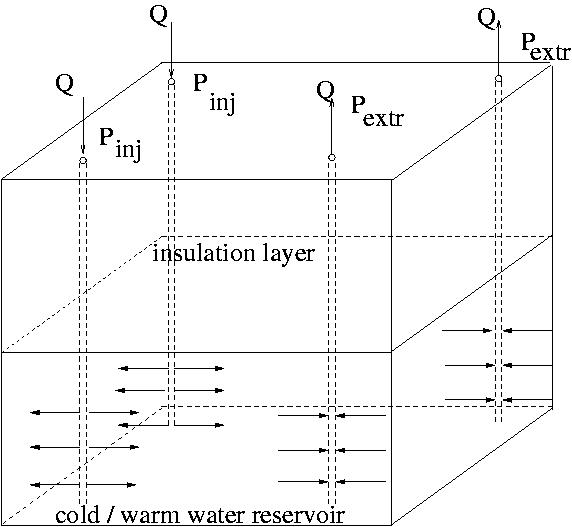Modelling water and heat transport in subsurface reservoirs of cold and
warm water
Jeroen Wille
Supervisor: Fred Vermolen and Jennifer Ryan
Site of the project:
Delft University of Technology
start of the project:
November 2008
In March 2009 the
Interim Thesis has been appeared
and a presentation has been given.
The Master project has been finished in July 2009
by the completion of the
Masters Thesis
and a final
presentation
has been given.
For working address etc. we refer to our
alumnipage.
Summary of the master project:
Since heating and cooling of large buildings is very energy consuming,
one
tries to find alternative, more efficient ways to heat or cool such
buildings.
A novel technique, which is applied nowadays to the building of the
faculty
EWI at the Delft University of Technology, is based on subsurface
storage
of heat and cold. The situation is as depicted in Figure 1, where a
subsurface
reservoir of warm and cold water is sketched. This reservoir is
separated
from the earth surface by a layer of well-insulating shale with a
thickness
of 10 meters approximately. The underground reservoir, itself, consists
of
grannular silicon. The communication between the building and the
reservoir is
by the use of wells (see Figure 1).

Figure 1: Schematic of the subsurface reservoir of cold and warm water.
The situation for
the summer is depicted here.
During summer warm water from the steerings of the building is injected
via the
well into the reservoir in order to have warm water that can be used for
heating
during the next winter, whereas from an other well cold water is
abstracted
for airconditioning from the reservoir by the use of an other well.
During
winter cold water is injected into the reservoir in order to have cold
water
for the cooling of the building for the next summer, whereas warm water
is
restrained from an other well for the heating of the building. This
provides
a cheap and efficient use of energy resources.
Motivation:
One remarkable observation is that in order to have the same volumetric
flow
of the injected water and extracted water is that the magnitude of the
extraction pressure is larger than the injection pressure. One of the
aims
of the aims of the project is to find an explanation of this
observation.
Work Proposed:
For this purpose, a model is developed, which takes into account the
flow
of cold and hot water in the porous medium (convection and Darcy's Law).
Further, temperature variations of the density of the sandstone are
taken into
account. This leaves us with an equation of state for the density of
the sandstone as a function of temperature and an additional equation
describing
heat transport. To compute the
solution of the system of equations a Finite Element Method is used.
For this purpose the Finite Element package SEPRAN can serve as a basis.
Further,
the obtained numerical solution is tested by the use of a
semi-analytical
solution for the equations.
This will be done by the following steps:
(a) literature survey,
(b) mahematical formulation,
(c) numerical implementation.

Contact information:
Kees
Vuik

Back to the
home page
or the
Master students page of Kees Vuik

![]()
![]()